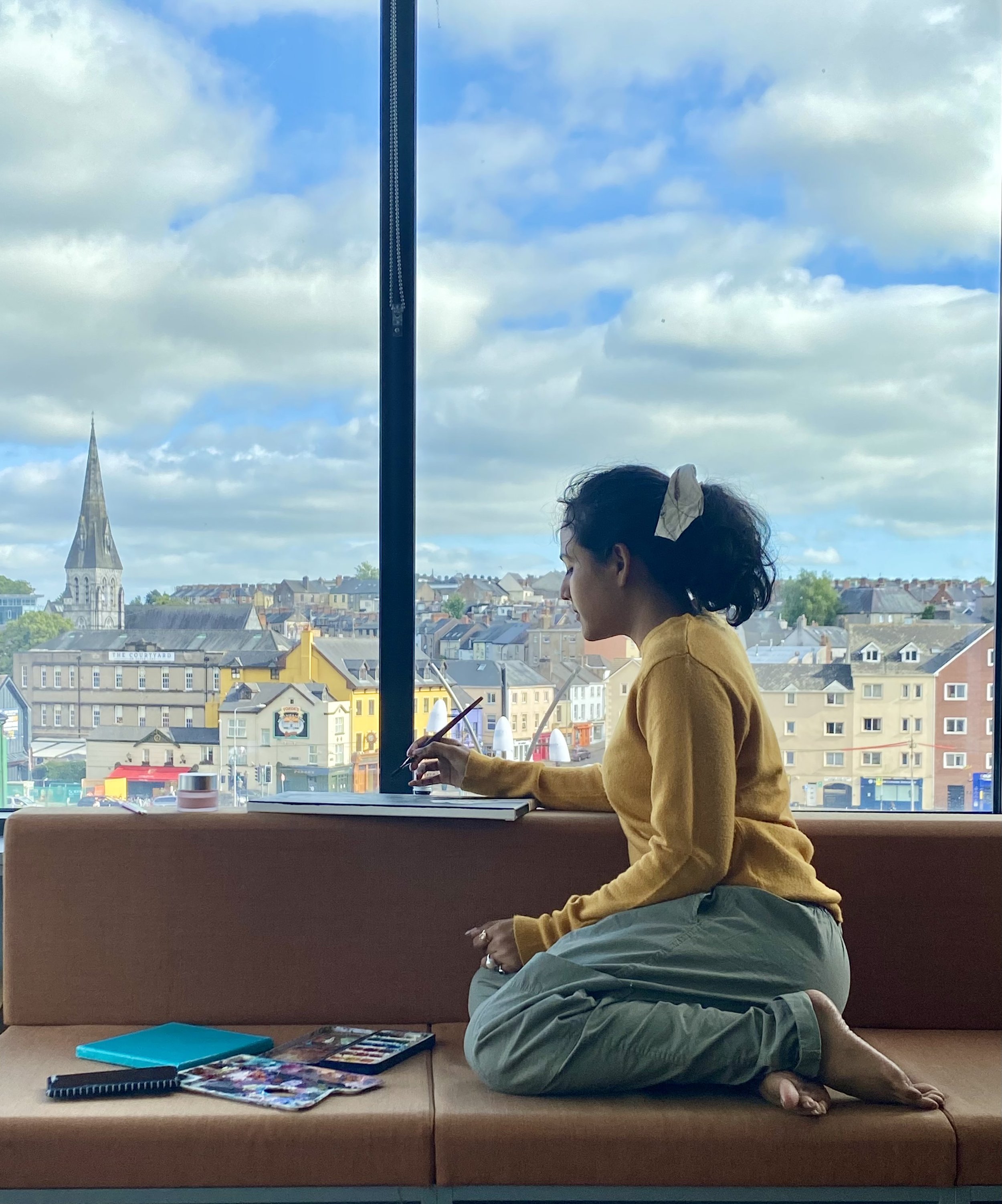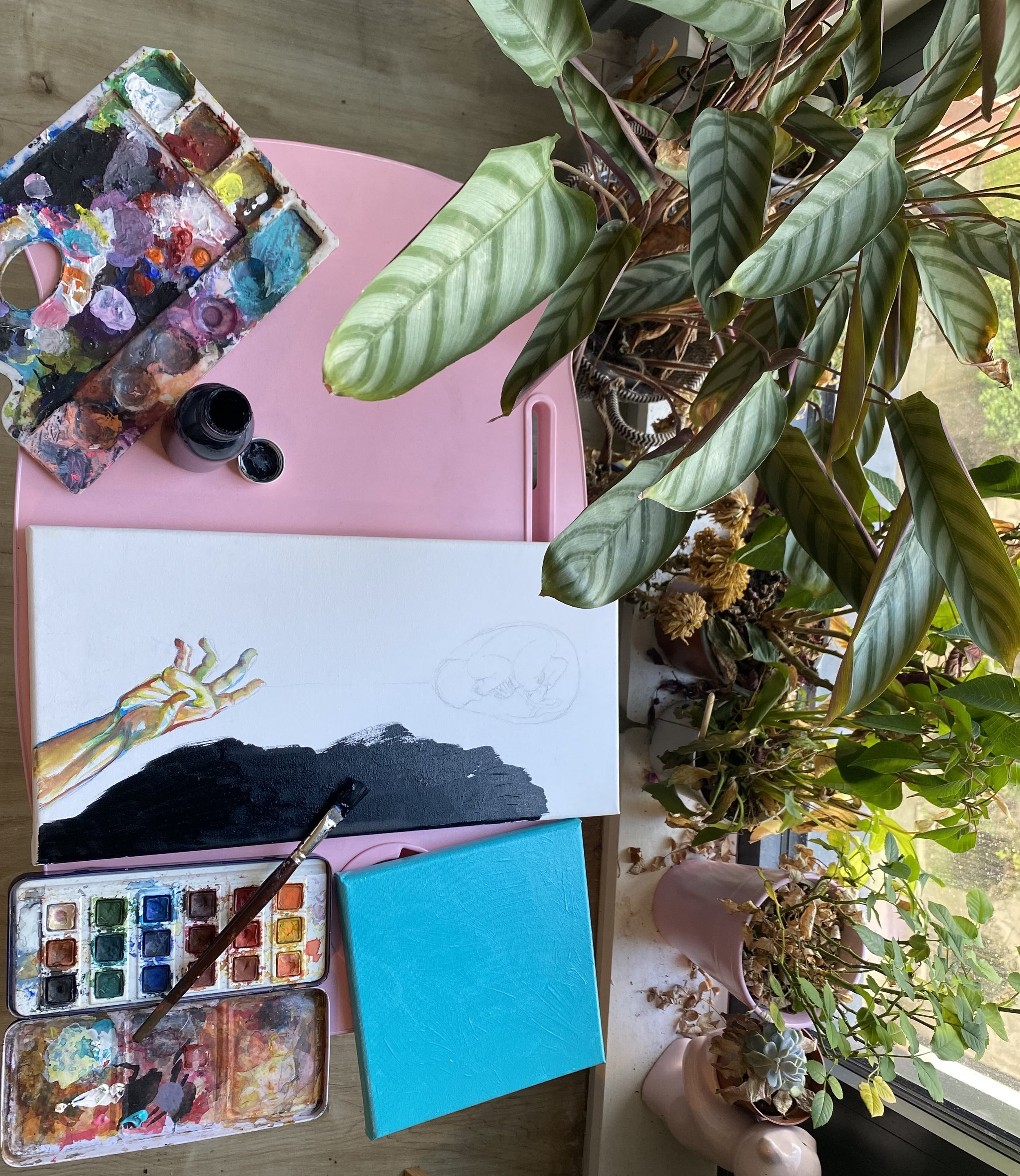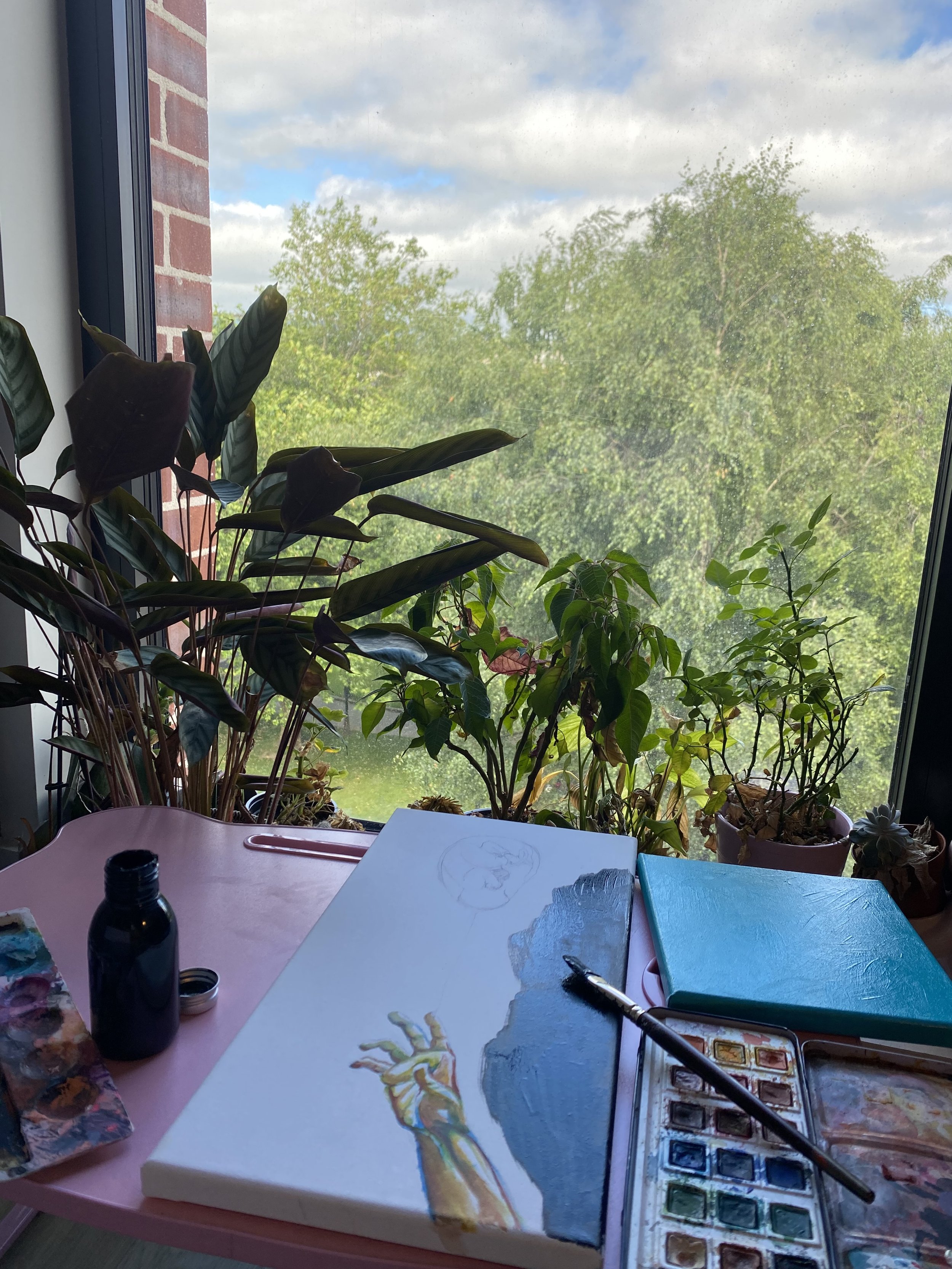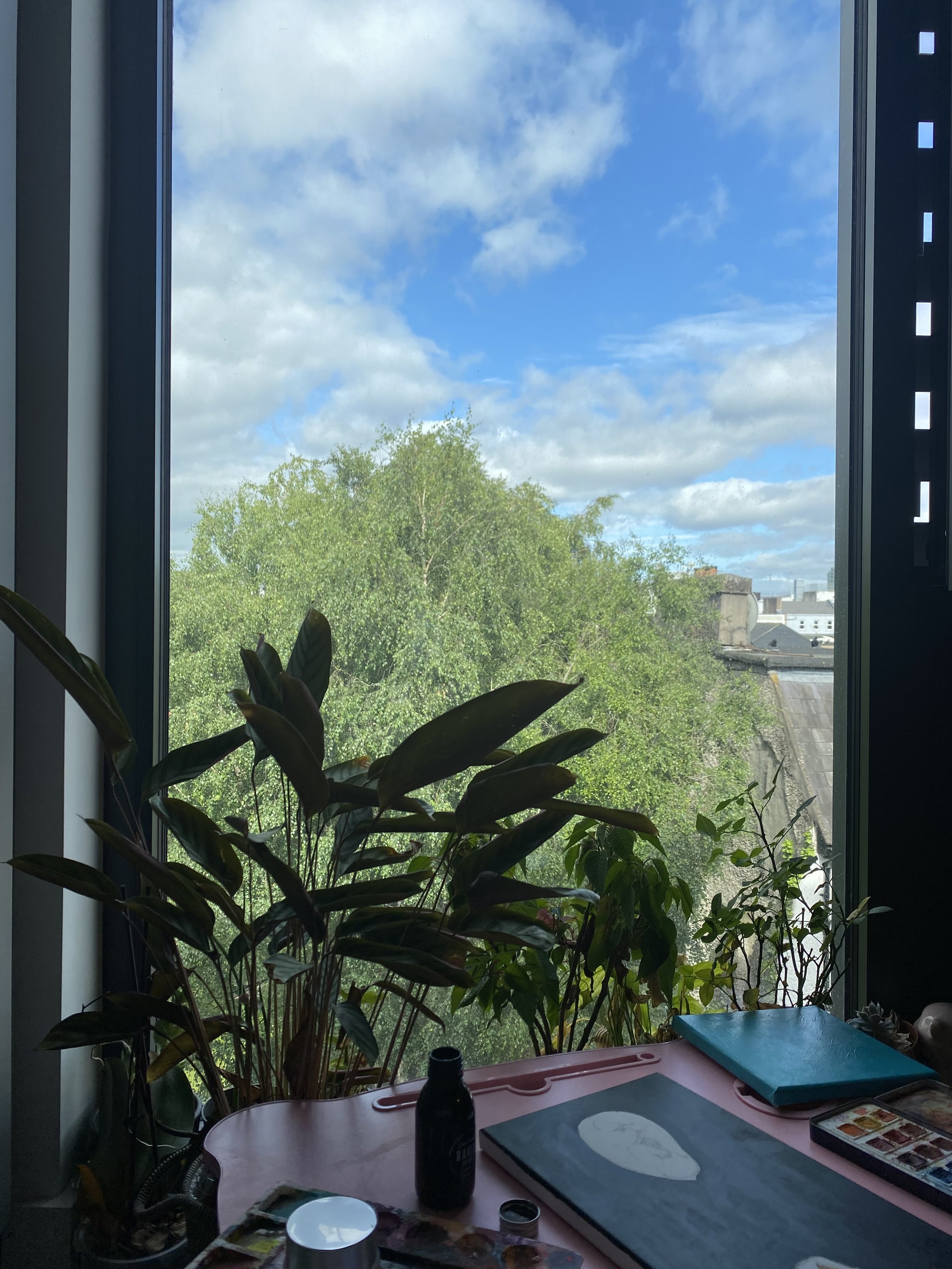Interview
Debismita Dutta
Born in Kolkata, India, Debismita is a 23-year-old surrealist watercolor painter who’s currently working in Ireland. Her work has been around the world, traveling to Cambodia, as well as different parts of India.
Throughout her childhood, she has been a recipient of multiple awards and accolades, including the prestigious Pidilite National Kala Kriti Art Contest.
Today, Debismita merges surrealist imagery with her love for human anatomy, painting complex takes on death and femininity. She works in mixed media as well as oil and acrylic.
Debismita is currently a PhD student in the Department of Engineering Sciences at University College Cork, Ireland, studying multiferroic data storage devices. Her passion for art and science leads her to pull from scientific images, anatomy, light studies, and sometimes molecular structures to create vibrant compositions.
Debismita experiments with nondescript colors, and surreal dream-like figures to convey convoluted ideas through an abstract medium.
What is your background and how did you start your journey?
“I’m lucky enough to have grown up all around my birth country, India and have allowed it to mold who I am today. I was born in Kolkata, which is an epicenter of art, culture, spirituality, and music. It has a rich history of painters, writers, and musicians whom I continue to learn from even today. Even though I was born in Kolkata, I grew up in Gujarat, where I got my eye for color. Gujarat during Navaratri and Uttarayan was a sight to behold — the textiles, colors, and food! Gujarat has a way of infusing color in things that aren’t even entirely visual. You couldn’t escape color in Gujarat even if you were blind. To ‘describe the color blue to a blind man’, you know where to take him.
I currently live in Mumbai, which is in Maharashtra, another state with its own distinct culture, cuisine, and rich literature. Mumbai gave me exposure to the bigger art scene in the country through exhibitions like Kala Ghoda, numerous art galleries, agencies, and an active art circuit.
I’ve always been an artist regardless of where I’ve been in life, whether it be doodling in notebooks, or painting a giant canvas right before my college deadlines. I don’t remember a distinct moment when I realized I was an artist. I don’t think anyone is NOT an artist. If you didn’t know who Andy Warhol was, you’d think he was just wiping off his hands on a canvas after a good day of playing Holi. The Solitary Reaper wouldn’t have been written by Wordsworth if it wasn’t for the solitary reaper herself. Intentionally or unintentionally, we all create art or become a cause in its creation, which makes us all artists by nature.”
What inspires you most?
“My inspiration typically comes from complex takes on philosophy, death, spirituality, and femininity. Other times, I just wish to paint a frog with butterfly wings. There’s really no in-between. I often draw from literary and religious references, and I’m quite inspired by the shapes in human anatomy.
I love the challenge of conveying ideas, concepts, and statements through surreal imagery. I’m a surrealist by design, as I consume a lot of information through visual mediums, and love how one can convey so much through simple dream-like imagery. But often, I enjoy making simple surreal images; images that exist just because they need to.”
“Asking ‘what was the artist feeling when she made this?’ is a far less interesting question than ‘what do I feel when I look at it?’
It’s very easy to find meaning in paintings that weren’t painted to convey a message, but just because the artist liked how it looked.
As an artist, I don’t take myself too seriously, and I try to leave any interpretation to the viewer.”
What themes do you pursue? Is there an underlying message in your work?
“My paintings have a very consistent theme of philosophy. At other times, I’m just being funny and painting whatever I like, such as octopus-hair ladies. I also like having poems accompany my paintings. I think they are quite complementary and feed meaning into each other, leading to a dynamic work of art.”
How would you describe your work?
“I’d call my work cool.”
Which artists influence you most?
“I love Dali and Kahlo with all my heart. I wouldn’t have known about surrealism if it wasn’t for their work. But I’d be lying if I said I’m not deeply inspired by Beksiński’s hellish compositions. They are dark, but carry a certain depth to them. You can tell the paintings weren’t made in teenage gothic angst, but came from real hardships and a war-forged perspective on life.
I learned about lighting and shadows from Rembrandt, and I get my understanding of colors from artists like Jamini Roy and Raja Ravi Varma. Both of them were known to use color sparingly but intentionally. I, however, intentionally stray away from a lack of color in my compositions.
The idea of tying pictures to poems came from Rabindranath Tagore, known for self-illustrating his literary work. Another artist I thoroughly respect is Araki. I relate to his sense of not giving a care, and never putting valves in his creative flow.”
What is your creative process like?
“I maintain an art idea journal, mainly because I always find myself teeming with ideas all the time, except for when I sit down to paint.
I don’t have a set process, but I usually begin by collecting references. Then I sketch out the composition to my liking before I start painting from the references, putting it all together. I always find myself going back to European anatomy painters to reference human organs or human anatomy in general. Sometimes, even though I’m not referencing them, I do keep a few paintings in front of me, just to set the tone of the work when I start.”
What is an artist’s role in society and how do you see that evolving?
“Artists are the closest thing we have to a time machine. They are a manifestation of the culture of an era, and their art can be used by someone from the future to travel back in time. If you wanted to know what the 1910s were like, your only way of doing so is by going through the art created during that time—the music, movies, clothing, and visual art. Artists preserve the existence of a generation, long after the generation is gone. We painted on cave walls with chalk and clay, and today that is our only connection with the early homo sapiens.
While this role remains unshaken, I believe that artists are now being tasked with an additional role of society-building. For ages, artists have said what the collective thinks or should think, but now artists would be judged on the basis of the same thought process if they do not act in line with those morals. Artists have usually been the anti-establishment voice, but now they are being tasked with building alternative establishments that incorporate their ideals. Actors, painters, musicians, writers are all a part of parliament now more than ever. If not, they are making their own companies and brands, challenging the status quo not just in voice, but also in action.”
Instagram: @debbielitating






